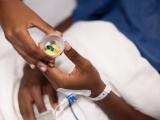The latest data from a national surveillance system that monitors foodborne bacteria for antibiotic resistance shows rising resistance to the drugs commonly used to treat Salmonella infections.
The findings come from the 2016-2017 National Antimicrobial Resistance Monitoring Systems (NARMS) Integrated Summary, which combines data from the Centers for Disease Control and Prevention (CDC), the Food and Drug Administration (FDA), and the US Department of Agriculture (USDA). The report provides a snapshot of antibiotic resistance patterns found in bacteria isolated from humans, raw retail meats (chicken, ground turkey, ground beef, and pork chops), and healthy animals at slaughter.
In addition to finding rising resistance to first-line antibiotics in human isolates of Salmonella, the NARMS data also show an increase in multidrug-resistant (MDR) Salmonella recovered from chickens and multidrug-resistant Campylobacter coli isolated from beef and dairy cattle.
Concerning trends in Salmonella
Overall, antibiotic resistance in Salmonella bacteria isolated from humans remains low, but the NARMS report shows some concerning trends. Ceftriaxone resistance rose from 2.8% in 2015 to 3.4% in 2017, and decreased susceptibility to ciprofloxacin rose from 5.8% in 2015 to 8.4% in 2017. The report suggests decreased susceptibility to ciprofloxacin was largely due to Salmonella Enteritidis and could be linked to international travel.
Resistance to azithromycin in human Salmonella isolates was rare, but 26 azithromycin-resistant isolates (1.1%) were identified in 2017 (compared with 26 found from 2011 through 2016). In addition, the percentage of human Salmonella isolates that were resistant to at least three classes of antibiotics saw a slight increase.
Decreased susceptibility to ciprofloxacin also rose in Salmonella isolated from retail chicken and turkey meat and from routinely sampled chickens and turkeys. The report says that increase was largely tied to an increase in MDR Salmonella Infantis. MDR Salmonella from routinely sampled chickens rose from 9.5% in 2015 to 18% in 2017 and from 15% to 25% in chicken cecal samples.
The surveillance data show that the percentage of ciprofloxacin-resistant Campylobacter jejuni found in humans rose from 25% in 2015 to 28% in 2017. Ciprofloxacin resistance was found in 39.4% of Campylobacter coli isolates from humans in 2017—roughly the same amount as in 2015. But the proportion of macrolide-resistant C jejuni isolates from humans and chickens remained low and unchanged (less than 3%), and macrolide resistance among C coli isolates from humans declined from 13% to 7%.
However, MDR C coli rose in beef cattle (from 7% in 2015 to 15% in 2017) and dairy cattle (from 4% to 11%). And the FDA cautions that the rates of macrolide resistance in Campylobacter isolated from swine and fluoroquinolone resistance in Campylobacter isolated cattle warrant further monitoring.
Monitoring antibiotic resistance in Salmonella and Campylobacter is important because the two pathogens are the leading causes of foodborne illness in the United States. The CDC estimates that Salmonella infections cause more than 1.2 million illnesses and 450 deaths a year, while Campylobacter infections cause more than 1.3 million illnesses and 120 deaths. The NARMS report also monitors resistance in Escherichia coli and Enterococci bacteria.
More timely data needed
On a positive note, no resistance to carbapenem antibiotics, which are used to treat MDR foodborne infections, was found in any Salmonella isolates from people, retail meats, or animals.
But nine Salmonella isolates and one pathogenic E coli isolate from humans were found to harbor MCR-1, a mobile gene that confers resistance to colistin, an antibiotic that has become the last option for treating infections that don't respond to other agents. The report says all ten patients traveled internationally before their illnesses began, which suggests they may have acquired it while traveling.
In addition, genomic testing identified a new colistin-resistance gene, MCR-9.1, in several isolates from humans and all retail and food animal sources. The FDA says further work is under way to fully characterize the gene.
"We know that colistin is one of these last-resort antibiotics that have become, unfortunately, really important in human medicine, because a lot of the other treatments are no longer working," said Karin Hoelzer, PhD, DVM, a senior officer with the Pew Charitable Trusts' antibiotic resistance project. "So seeing resistance to these drugs emerging, and seeing a multidrug-resistance increase, those are concerning trends."
The FDA says that, going forward, data available in NARMS reports will be updated on a rolling basis, which should reduce the amount of time between collecting samples of bacteria and publishing antibiotic resistance results. Hoelzer said that getting the data more quickly is critical.
"Having timely data is really important," said Hoelzer. "Having this data come out so many years after it was collected really limits how useful it is. The sooner the data can become available, the better."
Future reports will also have more data from the FDA's Veterinary Laboratory Investigation and Response Network (Vet-LIRN), which analyzes pathogens isolated from sick food animals and companion animals. The current report is the first time such data have been included.
See also:
Nov 22 2016-2017 NARMS Integrated Summary
Nov 22 FDA press release
























